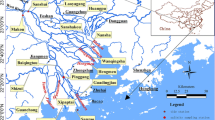Abstract
The Komesu underground dam is the first full-scale underground dam constructed to prevent saltwater intrusion in Japan. Although the cutoff wall of the dam effectively reduces the movement of saltwater into the reservoir area, saltwater masses remained behind the dam at the time of its completion, and saltwater can intrude beneath and diffuse through the wall, particularly when the reservoir level is below the sea level because of high pumping levels during the drought years. Therefore, it is necessary to estimate in advance whether the saltwater concentration in the pumped water is likely to exceed or not the permissible salinity level because of an increase in the residual saltwater mass as a result of saltwater intrusion and to take necessary measures to suitably manage the saltwater level behind the dam. To analyze saltwater intrusion, we first selected the optimal program suitable for the analysis of saltwater intrusion. Second, we examined the longitudinal dispersivity and the effect of the cone of depression around the pumping wells. Then we analyzed saltwater intrusion into the reservoir area in detail by using a two-dimensional convective–dispersive analysis. The results of the analysis make it possible to improve management of saltwater in the reservoir area behind the underground dam.
















Similar content being viewed by others
References
Boufadel M, Suidan M, Venosa A (1999) A numerical model for density-and-viscosity-dependent flows in two-dimensional variable saturated porous media. J Contam Hydrol 37:1–20
Guo WG, Langevin CD (2002) User’s guide to SEAWAT: a computer program for simulation of three-dimensional variable-density ground-water flow. US Geological Survey Techniques of Water-Resources Investigations 6-A7:77
Henry H (1959) Salt intrusion into fresh-water aquifers. J Geophys Res 64:11
Momii K, Hosokawa T, Kono K, Itoh T (1989) Estimation method of transverse dispersivity based on vertical salt concentration distribution in coastal aquifer. In: Proceedings of Japan Society of Civil Engineers, vol 411(II)-12, pp 45–53 (in Japanese)
Nawa N, Nakao J, Miyazaki K, Muramami G (2008) The analysis method of salt water intrusion and the field test for dispersion paramerters in Komesu underground dam. J Jpn Soc Irrigation Drainage Rural Eng 76-1:21–24 (in Japanese)
NIPOOMISAD (The National Irrigation Project Office of The Okinawa Main Island Southern Area District) (2006) Engineering journal-national irrigation project at Okinawa Main Island southern district, pp 133–152 (in Japanese)
Nishigaki M, Hishiya T, Hashimoto M, Kouno I (1995) The numerical method for saturated–unsaturated fluid density-dependent groundwater flow with mass transport. In: Proceedings of Japan Society of Civil Engineers, vol 511(III)-30, pp 135–144 (in Japanese)
Nishigaki M, Mitsubishi Materials Corp, Daiya Consultant Corp (2001) Density-dependent transport analysis. Saturated–unsaturated porous media: 3-dimensional Eulerian Lagrangian method (in Japanese)
Sauty JP (1989) An analysis of hydrodispersive transfer in aquifer. Water Resour Res 16(1):145–158
SES (Soil Engineering Society) (2002) Survey, estimation and measure of soil and groundwater pollution, Hokosha Publication, pp 107 (in Japanese)
SGGP (Study Group of Groundwater Problem) (1991) Pollution theory of groundwater: foundation and application. Kyoritu Publication, pp 197–208 (in Japanese)
Voss CI, Provost AM (2003) SUTRA: a model for saturated–unsaturated, variable-density groundwater flow with solute or energy transport, U.S. Geological Survey Water-Resources Investigations Report 02-4231, pp 250
Acknowledgments
This case study was carried out by the officials of the National Irrigation Project Office of the Okinawa Main Island Southern Area District (NIPOOMISAD) and Sanyu Consultant Inc. (SCI). The authors would like to thank Mr. Kenichi Yokota, Mr. Shinichi Tamada, Mr. Susumu Aoki and Mr. Jin Nakao, who were then the officials of NIPOOMISAD, Mr. Shigeru Sugiyama and Mr. Gen Murakami are officials of SCI. This study was carried out with the support of the Underground Dam Technical Study Board. The authors would like to thank Dr. Takashi Hasegawa, Dr. Taro Okamoto, Dr. Hiroyasu Furukawa and Dr. Masayuki Imaizumi of the board for their valuable advice to this study. Finally, the authors would like to thank Dr. Kazurou Momii and Dr. Kei Nakagawa for their valuable advice on the water tank experiment and analysis of longitudinal dispersivity by tracer test.
Author information
Authors and Affiliations
Corresponding author
Rights and permissions
About this article
Cite this article
Nawa, N., Miyazaki, K. The analysis of saltwater intrusion through Komesu underground dam and water quality management for salinity. Paddy Water Environ 7, 71–82 (2009). https://doi.org/10.1007/s10333-009-0154-1
Received:
Revised:
Accepted:
Published:
Issue Date:
DOI: https://doi.org/10.1007/s10333-009-0154-1




